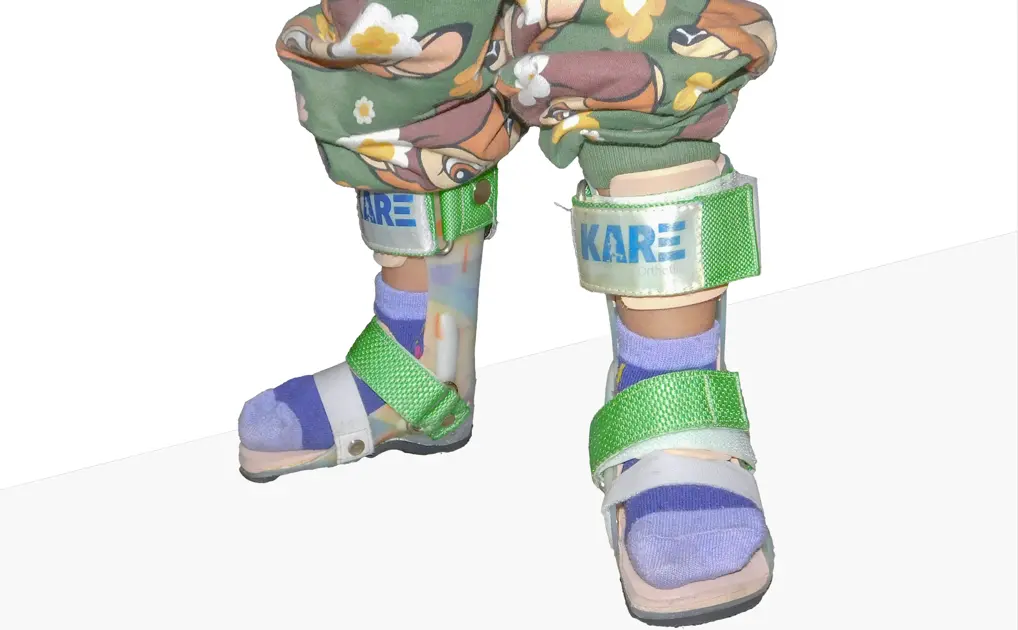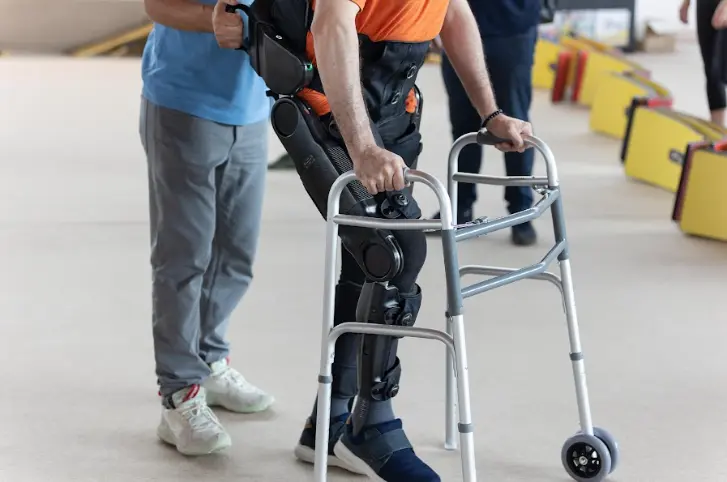
An Ankle Foot Orthosis (AFO) is a medical device used to support the ankle and foot in individuals with conditions like foot drop, cerebral palsy, or post-stroke weakness. It improves mobility, stabilizes gait, and reduces fall risk.
What is an Ankle Foot Orthosis Used For?
Do you or your child have issues with your ankles or feet? Are these problems caused by cerebral palsy or other neurological conditions? The Ankle Foot Orthosis helps stabilise the foot and ankle joint. It’s often recommended for those with limited mobility. This includes people with conditions like cerebral palsy, stroke, multiple sclerosis, and other medical conditions.
An AFO is prescribed to enhance mobility, correct deviations in gait, and prevent contractures. It can also reduce ankle movement and support weak muscles in the lower leg. This helps keep the foot and ankle in a neutral position. Stability in the lower body helps people move with greater ease. It also improves balance and makes walking safer while reducing tiredness.
Go forward to learn about AFOs, their uses, types, assessment, fitting, common questions about AFOs, and misconceptions.
What are the Benefits of AFO?
Ankle-foot orthosis is the best supportive system for you.
- Enhance your mobility by making walking much more manageable and smoother.
- Minimises the risk of falls by increasing your stability and balance.
- Relieves joint stress and muscle fatigue by reducing pain and discomfort.
- Protects against progressive foot and ankle issues.
- Prevents you from foot drop and keeps the foot in a functional position, which also helps to reduce dragging.
Features of AFO
- An AFO is a safe, results-oriented device that can be used for any ankle and foot-related issue.
- AFOs use lightweight materials like carbon fiber, plastic, or light metals. This makes them easy to move and adjust during use.
- In any AFO, there is an adjustable strap to ensure a secure and comfortable fit for you.
- With the ventilation holes, sweating would be less, improving comfort. People would also be free from itching or any other skin issues.
- AFO is customisable because each individual has different measurements, needs, and preferences.
What are all the Medical Conditions Treated with AFO?
The AFO is an excellent choice for mobility problems. It delivers strong support and stability.
Foot drop is caused by nerve damage, multiple sclerosis (MS), or stroke. It makes the individual very risky, as lifting the foot while walking is difficult. Using an AFO, one can keep the foot in an appropriate position and prevent tripping.
- Cerebral palsy: CP impacts both kids and adults. People with CP usually face muscle stiffness and struggle with coordination.
- Stroke recovery: Stroke creates weakness or one-sided paralysis in the body. In that case, these AFOs can assist you with good balance and rehabilitation. They give you a more natural gait.
- Multiple Sclerosis(MS): affects muscle control and strength. AFO can help stabilise the foot and ankle by reducing fatigue and increasing walking efficiency.
- Spinal cord injuries: It can weaken or paralyse muscles in the lower limbs. However, they also provide necessary support to regain mobility.
- Post-surgical rehabilitation: If you undergo foot or ankle surgery, the AFO aids in healing by preventing misalignment and ensuring proper movement recovery.
What are Different Ankle Foot Orthosis (AFO) Types Used?
There are various types, and each AFO is designed to support different and specific mobility needs.
1. Rigid/ Solid AFO
It completely restricts ankle movement while providing maximum stability. It is best for patients with severe foot drop, leg muscle weakness, or ankle immobilisation.
A stroke recovery patient with ankle weakness can use a rigid AFO. This keeps their foot fixed and stops unnecessary movement.
2. Hinged/ Articulated AFO
- A hinged AFO allows for controlled ankle movement. It offers better stability, making it ideal for those with mild foot drop or cerebral palsy.
- A child with cerebral palsy can sometimes use a hinged AFO. This device supports the foot and allows the ankle to move, which helps to improve walking.
3. Dynamic AFO
Dynamic AFOs provide flexible support that promotes natural foot movement. They are best for individuals with mild to moderate mobility problems, especially children.
4. Posterior Leaf Spring AFO
Posterior leaf spring AFOs offer gentle support. They assist in lifting the foot during walking. They work well for people with mild foot drop who need help lifting their feet.
5. Carbon Fiber AFO
It is lightweight and durable, crafted for energy return and efficiency. It is best for active individuals who need both support and flexibility. A great example is a runner with foot drop. They can use a carbon fiber AFO for stability and still feel free.
6. Custom-Made AFO
This custom-made AFO will be helpful for your foot and condition. In some complex cases, non-customised devices will be necessary.
7. Off-the-Shelf AFO
This type of AFO is pre-made, ready to use, and more affordable than custom AFOs. Temporarily or mildly ill conditions need quick support. For example, a person healing from ankle surgery can improve short-term stability.
How Much Do Ankle Foot Orthotics Cost?
The cost of an AFO really depends on what kind you need. If it’s a basic, ready-made one, it might cost around ₹5,000 to ₹10,000. But if you need something custom-made designed just for your leg and condition, it can go up to ₹30,000 or more.
It also depends on the material, design, and the clinic or hospital you go to. The best thing to do is talk to an orthotist, they’ll guide you on what’s right for you and give you a clear idea of the cost. And don’t forget, some insurance plans may help cover part of it!
Need help choosing the right AFO?
Talk to our experts at KARE Prosthetics & Orthotics for a free consultation and personalised guidance.
👉 Call now or book an appointment today!
Conclusion
AFOs (Ankle Foot Orthoses) are new mobility equipment. They boost the quality of life for people with various disabilities. These devices begin with stability and support rehabilitation. They meet different needs and provide specific solutions that fit easily into people’s lives. Users can expect a positive change with the right AFO and a properly fitting prescription.
With the help of physical therapy, they’ll notice improvements in their walking style, posture, and movement. Future AFO models will likely offer more personalisation and better performance thanks to improved technology. Explore the many opportunities AFOs offer. A step toward better mobility and stability.
KARE Prosthetic and Orthotics India provides the best orthotic Ankle Foot Orthosis solutions to meet your needs. We are ready to assist you with perfect AFOs that correct your leg. Don’t worry whether you are searching for pediatric or adult-oriented, get the customised AFO that gives the best results for your foot. Don’t wait to take action!
Other Details
What is an AFO Assessment?
Assessing AFOs means taking precise measurements for each person. This includes checking their functional abilities and performing both static and dynamic assessments.
- Functional assessment: This assesses patients’ ability to perform daily activities and gait patterns. It helps identify the need for an AFO and the type of support needed.
- Static assessment: This is the best way to check foot shape, alignment, and deformities. It also measures the range of motion in the ankle and joints and determines muscle strength.
- Dynamic assessment: It highlights gait analysis and examines how people walk to detect abnormalities. This assessment will discuss how the foot supports weight during various walking movements.
Patient Education and Training for Ankle Foot Orthoses
Educating patients on using and maintaining their ankle-foot orthosis splints is essential. This covers daily cleaning, spotting signs of discomfort, and properly using the device.
Implementing AFOs in Daily Life
Wearing AFOs in different settings, such as at home or in therapy, helps users integrate them into their daily lives, which is important for successful rehabilitation.
What are Some Common Problems with AFOs?
Some users might have skin issues or discomfort from a poor fit or misalignment. This shows why a good fit and regular adjustments are essential.
Physical Therapy with AFOs
Physical therapy exercises help AFO users. Heel raises, ankle flexion and extension, and balance training strengthen muscles, leading to better mobility.




